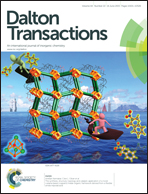1,2,4-Triphospholyl anions – versatile building blocks for the formation of 1D, 2D and 3D assemblies†‡
Abstract
The potential of K[P3C2R2] (R = tBu, Mes) as building blocks in metallo-supramolecular chemistry was investigated and self-assembly processes with Cu(I) halides resulted in the formation of a large variety of unprecedented one-, two- and even three-dimensional aggregates. The 3D networks showed an interesting topological similarity to allotropes of carbon: diamond and the theoretically proposed polybenzene. Furthermore, the negative charge of the phospholyl ligand favoured the generation of cationic CuaXb (a > b, X = Cl, Br, I) assemblies, a challenging area within the well-studied coordination chemistry of CuX units. In addition, the 1D strands were also characterized in solution, revealing the presence of oligomeric units.


 Please wait while we load your content...
Please wait while we load your content...